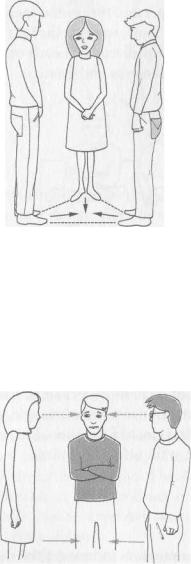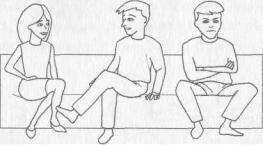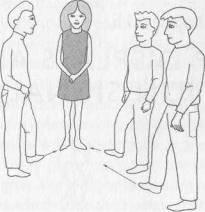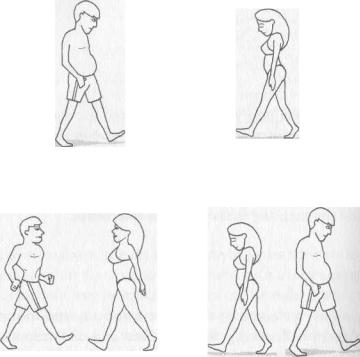
Books on Happiness / The Definitive Book Of Body Language- 2 students
.pdf
How the Body Points to Where the Mind Wants to Go
by the first two people, which invites a third person to join in the conversation.
Open triangular position encouraging the entry of a third person
If a third person wants to join two others who are standing in a Closed Position, he'll be invited only when the other two angle their bodies to form the triangle. If the third person is not accepted, the others will hold the Closed Position and turn only their heads towards him as a sign of recognition; and they will probably give tight-lipped smiles.
Time to leave — the new person is not accepted by the others
A conversation between three people may begin in the open triangle position but eventually two people may take the Closed Position to exclude the third person. This group formation is a clear signal to the third person that he should leave the group to avoid embarrassment.
283

The Definitive Book of Body Language
Seated Body Pointing
Crossing the knees towards another person shows a sign of interest in or acceptance of that person. If the other person also becomes interested, he will cross knees towards the first person. As the two people become more involved with each other they begin to mirror each other's movements and gestures.
Body Pointing is used to close off a couple and exclude the man on the right
In the picture above, the man and woman to the left have formed a closed position that excludes all others, such as the man on the right. The only way in which the man on the right could participate in the conversation would be to move a chair to a position in front of the couple and attempt to form a triangle, or take some other action to break their closed formation. But, for now, they'd like him to take a long walk off a short pier.
Foot Pointing
Not only do the feet serve as pointers indicating the direction in which a person's mind is going, they also point at people who we find the most interesting or attractive. Imagine you are at a social function and you notice a group of three men and one woman. The conversation seems to be dominated by the men, and the woman is just listening. Then you notice that the men all have their front foot pointing towards the woman.
284

How the Body Points to Where the Mind Wants to Go
Feet signalling what's on the owner's mind
With this simple non-verbal cue, the men are each telling the woman they're interested in her. On a subconscious level, she sees the foot gestures and is likely to stay with the group for as long as she is receiving this attention. She's standing with both feet together (neutral) and could eventually point one foot towards the man she finds the most interesting.
Summary
Few people ever consider the effect that body and foot pointing play in influencing the attitudes and the responses of others. If you want to make others feel comfortable use the 45degree Open Position and, when you need to exert pressure, use the direct body point. The 45-degree position allows the other person to think and act independently, without feeling pressured. Never approach men directly from the front or women from behind.
These body pointing skills take a little practice to master but they can become natural before long. In your day-to-day encounters with others, foot pointing, body pointing and positive gesture clusters such as open arms, visible palms, leaning forward, head tilting and smiling can make it easy for others not only to enjoy your company, but to be influenced by your point of view.
285

Chapter 15
COURTSHIP DISPLAYS AND ATTRACTION SIGNALS
1. A man and woman approaching on a beach
2. They see each other |
3. They pass |
Dr Albert Scheflen, author of Body Language and the Social Order, found that, when a person enters the company of the opposite sex, certain physiological changes take place. He found that high muscle tone became evident in preparation for a possible sexual encounter, 'bagging' around the face and eyes decreased, body sagging disappeared, the chest protruded, the stomach was automatically pulled in, pot-bellied slumping disappeared, the body assumed an erect posture and the person appeared to become more youthful in appearance. He noted that both men and women walked with a livelier,
286
Courtship Displays and Attraction Signals
springier gait as a display of health and vitality and to convey their suitability as a partner. A man will stand taller, protrude his jaw and expand his chest to make himself appear dominant. A woman who is interested will respond by emphasising her breasts, tilting her head, touching her hair, exposing her wrists and thereby making herself appear submissive.
The ideal place to observe these changes is on a beach when a man and a woman approach each other from a distance. The changes take place when they are close enough to meet each other's gaze and will continue until after they have passed each other, at which time their original posture returns.
Body language is a fundamental part of courtship because it reveals how available, attractive, ready, enthusiastic, sexy or desperate we are. While some courtship signals are studied and deliberate, others, such as those just mentioned, are completely unconscious. It is still unclear how we learn these signals but research now shows that many may be inborn.
The Emergence of the Colourful Male
In the majority of mammals, it's the male that 'dresses up' to impress the less than colourful females. Humans, however, do it the other way around. For centuries, women have done most of the sexual advertising by decorating themselves in colourful clothing and jewellery and painting their faces. The exception to this was during the sixteenth and seventeenth centuries in Europe when men adorned themselves with beautiful wigs and colourful clothing and out-dressed the average woman. Keep in mind also that, historically, while women have dressed to attract men, men have dressed in clothing to either show status or to frighten away enemies. Today we see the re-emergence of the self-obsessed male who is again beginning to decorate himself like a peacock. We see footballers having facials and manicures, and wrestlers tinting their hair. In the USA we have seen the emergence of the 'metro-sexual' male — a heterosexual male who copies women's behaviour patterns — he has
287
The Definitive Book of Body Language
manicures, pedicures and hair colouring, wears fancy clothes goes to the jacuzzi, eats organic vegetarian food has botox, a face-lift and is in touch with his 'feminine side'. While the 'metro-sexual' male seems an oddity to many straight men, our observation shows 'metro-sexuals' fall into three categories: gay men; effeminate men; and men who realise that assuming traditional female behaviours is a great way to meet lots of women.
Graham's Story
Graham was a man who developed a skill that most men would kill to have.
He would attend a social function and somehow quickly 'scope out' the available women, make his choice and, in almost record-breaking time, would be seen heading towards the exit with her, escorting her to his car and driving back to his apartment. He would return to the function and repeat this process, sometimes several times in the same evening. He seemed to have a built-in radar for finding the available women at the right time and getting them to go with him. No one knew how he did it.
Research by animal courtship behaviour zoologists and behavioural scientists reveals that male and female animals use a series of intricate courtship gestures, some obvious and others subtle, and that most of this is done subconsciously. In the animal world, courtship behaviour in each species follows specific and pre-determined patterns. For example, in several species of bird, the male struts around the female giving a vocal display, puffing up his feathers and performing many intricate body movements to gain her attention, while the female appears to display little or no interest. This ritual is similar to that performed by humans when courtship begins.
Human flirtation involves sequences of gestures and expressions not unlike the courtship dances of birds and other animals, as seen on wildlife programmes.
288
Courtship Displays and Attraction Signals
The bottom line is that when a person wants to attract the opposite sex they do so by emphasising sexual differences. To discourage the opposite sex we play down or hide these differences.
Highlighting gender differences is what makes a person look 'sexy'.
Graham's technique was first to spot women whose body language indicated they were available and then to respond with his own male courtship gestures. Those who were interested would return the appropriate female signals, giving him the non-verbal green light to proceed to the next stage.
The success women have in intimate encounters is directly related to their ability to send courtship signals to men and to decode those being sent back. For a man, success in the mating game relies mainly on his ability to read the signals being sent to him, as opposed to being able to initiate his own moves. Most women are aware of courtship signals but men are far less perceptive, often being completely blind to them, which is why so many men have difficulty finding potential mates. Women's difficulty in finding partners is not about reading signals, it's more about finding a man who'll match their criteria.
Graham somehow knew exactly what to look for and women would describe him as sexy, masculine, humorous and 'someone who makes me feel feminine'. This was their reaction to the constant attention he'd give them and the courtship signals he used. Men, on the other hand, described him as 'aggressive', 'insincere', 'arrogant' and 'not particularly funny' ~ their reaction to the competition Graham represented. Consequently, Graham had few male friends for obvious reasons - no man likes a potential rival for the attentions of his woman. This chapter is devoted to the female signals Graham could see and to the body language he used in return.
2 89
The Definitive Book of Body Language
Why Women Always Call the Shots
Ask any man who usually makes the first move in courtship and he will invariably say that men do. All studies into courtship, however, show that women are the initiators 90% of the time. A woman does this by sending a series of subtle eye, body and facial signals to the targeted man, who, assuming he is perceptive enough to pick them up, responds to them. There are men who will approach women in a club or bar without being sent the green light but, while some of these men are regularly successful with finding partners, their overall statistical success rate is low because they weren't invited first - they're simply playing the numbers game.
In courtship, women call the tunes most of the time - men do most of the dancing.
In these cases, if a man detects that his approach will be unsuccessful he's likely to pretend he's come to talk to her about other unrelated things and he will use corny lines like, 'You work at the National Bank don't you?' or Aren't you John Smith's sister?' To be successful in courtship by playing the numbers game a man has to approach a lot of women to make a sale - unless, of course, he looks like Brad Pitt. Any man who crosses the floor to chat up a woman has usually done so at her request after picking up her body language signals. It just looks as if he made the first move because he made the walk across the floor. Women do initiate up to 90% of flirtatious encounters but it is done so subtly that most men think they are the ones taking the lead.
Differences Between Men and Women
Men find it difficult to interpret the more subtle cues in women's body language and research shows that men tend to
290
Courtship Displays and Attraction Signals
mistake friendliness and smiling for sexual interest. This is because men see the world in more sexual terms than women; men have 10 to 20 times more testosterone than women, which makes them see the world in terms of sex.
To some men, when a lady says 'no' she means maybe; when she says 'maybe' she means 'yes'; but ifshe says 'yes' she's no lady.
When they meet a possible partner, women send out subtle, but often deceptive, courting signals to see whether he's worth pursuing. Women tend to bombard men with courting rituals in the first minutes of meeting them. Men may misinterpret these signals and make a clumsy pass. By sending erratic and ambiguous signals in the early stages, women manipulate men into showing their hand. This is one reason why many women have trouble attracting men — men become confused and won't make an approach.
The Attraction Process
As with other animals, human courtship follows a predictable five-step sequence that we all go through when we meet an attractive person.
Stage 1. Eye contact: She looks across the room and spots a man she fancies. She waits till he notices her then holds his gaze for about five seconds and then turns away. He now keeps watching her to see if she does it again. A woman needs to deliver this gaze, on average, three times before the average man realises what's happening. This gaze process can be repeated several times and is the start of the flirting process.
Stage 2. Smiling: She delivers one or more fleeting smiles. This is a quick half smile that is intended to give a prospec-
291
The Definitive Book of Body Language
tive man the green light to make an approach. Unfortunately, many men are not responsive to these signals, leaving the woman feeling that he's not interested in her.
Stage 3. Preening: She sits up straight to emphasise her breasts and crosses her legs or ankles to show them to best advantage or, if she's standing, she tilts her hips and tilts her head sideways towards one shoulder, exposing her bare neck. She plays with her hair for up to six seconds — suggesting she is grooming herself for her man. She may lick her lips, flick her hair and straighten her clothing and jewellery. He'll respond with gestures such as standing up straight, pulling his stomach in, expanding his chest, adjusting his clothing, touching his hair and tucking his thumbs into his belt. They both point their feet or entire bodies towards each other.
Stage 4. Talk: He approaches and attempts to make small talk, using cliches such as, 'Haven't I seen you somewhere before?' and other well-worn lines that are purely intended to break the ice.
Stage 5. Touch: She looks for an opportunity to initiate a light touch on the arm, either 'accidental' or otherwise. A hand touch indicates a higher level of intimacy than a touch on the arm. Each level of touch is then repeated to check that the person is happy with this level of intimacy and to let them know that the first touch was not accidental. Lightly brushing or touching the shoulder of a man is done to give the impression that the woman cares about his health and appearance. Shaking hands is a quick way to move to the touch stage.
These first five stages of courtship may seem minor or even incidental but they are critical to starting any new relationship and are the stages that most people, especially men, find difficult. This chapter will examine the signals that are most likely to be sent by men and women - and Graham - during these stages.
292
